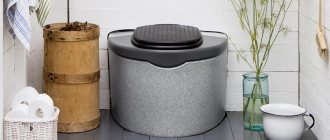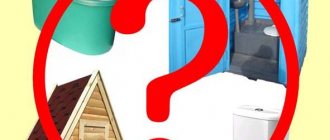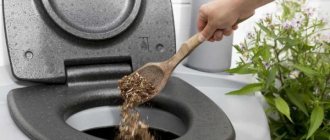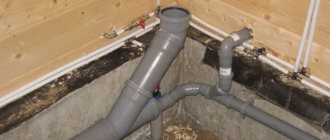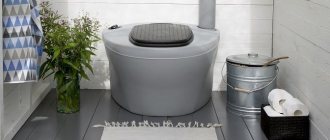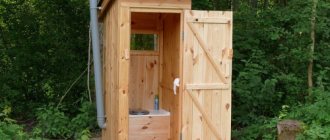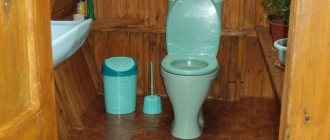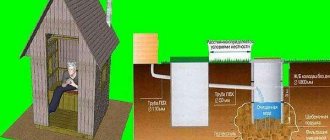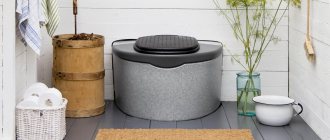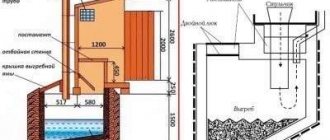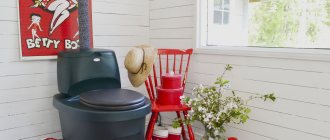General information
Ekomatic is a peat dry closet, which was developed specifically for summer cottages by the Finnish company Kekkila. This model came to Russia 25 years ago. As of 2021, the Finnish company managed to sell more than 300 thousand copies and acquired several production centers for its products in Russia.
Composting dry toilet Kekkila Ecomatic
An ecomatic toilet does not need to be connected to a water supply, electrical network or sewerage system. The model under consideration is completely autonomous, so for its operation you do not need to buy special composting or cleaning products.
The body of the dry closet consists of plastic - a durable and environmentally friendly material. In extreme heat, the ecomatic toilet does not emit toxic substances or unpleasant odors, thanks to the reliable sealing of the connecting seams. The model under consideration is safe for humans and the environment.
Dimensions of the Kekkila Ecomatic dry closet
The main advantages of the Ekomatic dry toilet are its compact dimensions: HxWxD 960x600x780 and a spacious waste tank of 110 liters, the volume of which allows you to service the model once a year. The second advantage of the Ekomatic dry toilet for a summer residence is the full composting cycle. That is, in the allotted time, the waste completely ripens and can be immediately used as organic fertilizer.
The peat dry closet has two modes of operation. The first mode is intended for using the device in hot weather, and the second was developed specifically for the cold regions of Russia. The “summer” mode is ideal for a summer house located in the temperate zone. A dry toilet in this mode requires a large amount of water and generous sprinkling of waste with a dry peat mixture. In winter mode, the toilet switches to reduced water consumption. The dry closet automatically prepares itself during the winter, removing excess liquid from the storage tank.
Innovative technology is ideal for a rarely visited cottage. With its help, the peat dry closet produces high-quality compost, despite the cold weather and prolonged stagnation.
The best peat toilets according to Ecotoilet:
3rd place.
Ecomatic 50 . The most affordable Finnish peat toilet. A popular model with a rotating container so that waste is evenly distributed.
Biolan Complet. Reliable “indestructible” Finnish toilet on wheels with a large volume of 140 liters ! You can forget about taking it out for a long time.
Piteko 506 . The most popular model : smooth plastic, comfortable stem, everything included, great price.
Source
Advantages of the model
In the market of autonomous sanitary products, the Finnish dry closet is famous for the following advantages:
Construction of a peat dry closet
- The toilet operates autonomously and does not need to be connected to a water supply or sewerage system;
- High-quality sealing of the seams of the upper and lower parts prevents the release of unpleasant odors;
- Transforms human waste products into compost - high-quality organic fertilizer;
- Uniform distribution of waste in the storage tank;
- Connects to a drainage hose, through which excess liquid is drained from the reservoir to the garden;
- The volume of the storage tank allows you to use the device for a year without maintenance (for a family of 4 people);
- The durable case, made of plastic, guarantees the absence of dents and defects due to mechanical damage. The body can support a person up to 200 kg.
The small size turns the toilet into a compact and self-contained device for the garden.
Peat composting toilet Ekomatic
Features of choosing peat dry closets
Choosing a composting dry closet is essentially a two-step process.
First of all, the technical parameters of the model necessary for comfort of use are determined.
- The overall overall dimensions of the structure must correspond to the size of the room in which the peat dry closet will be installed.
- The required tank capacity is not so easy to determine. On the one hand, a large volume will allow you to increase the periods between compost unloadings, even when using the recycler with a large family. On the other hand, depending on the characteristics of the model and the type of backfill used, there are restrictions on the time during which the mixture of waste and peat can remain in the tank. Without timely cleaning, the quality of the compost will be reduced and an unpleasant odor may appear. It is optimal if the tank is filled before the set period expires.
When choosing a peat toilet, pay attention to the features of its design.
- A level indicator will save you from unnecessary hassle and the need to periodically check the condition of the tank.
- The dispenser promotes economical consumption of peat.
- The dispenser-distributor increases the efficiency of the model.
Finnish dry toilet Termotoilet with a heat-insulated body is suitable for a large family
Composition selection
- Some composting toilets use ash, sawdust and other compounds as backfill, but they are much less effective due to the lack of special bacteria that process waste.
- Peat supplies the necessary microorganisms, therefore it is considered the most effective consumable material for toilets of this type.
- A mixture of peat and sawdust, which ensures aeration of the composition, is made in a 1:1 ratio.
If you are planning to buy a heated washbasin for your garden, then you may be interested in our article describing the various models.
And instructions for building a composting peat toilet yourself can be found here.
Installation of a dry toilet
The kit includes the following parts: housing, ventilation pipe, drain hose, clamps, cover, rubber gasket for the ventilation pipe and a thermal seat with an opening lid. This kit allows you to assemble the toilet with your own hands as quickly as possible and without the use of special tools.
Installation of a Kekkila Ecomatic dry toilet
A peat dry toilet can only be located indoors, so it is recommended to build a toilet house at the dacha. The following materials are used to build the house: wood or metal profiles. It is worth noting that the compact size of the dry closet allows you to install the composting device not only in toilet houses, but also in other rooms.
Installation begins with markings. Place the peat dry closet at the installation site and make marks along the contour of the storage tank and where the ventilation pipe passes. Check that the ventilation pipe coming from the dry closet does not interfere with the opening of the seat.
It is better to place the dry closet in the middle of the room. The location of the Ekomatic toilet should not interfere with the opening of doors or the free movement of people. The next step is to install the ventilation pipe. The ecomatic toilet has a ventilation hole at the back - you need to connect a pipe to it, tightening it with a clamp. It is recommended to immediately seal the connecting seams. You can use plumber's or silicone sealant.
Peat is poured into the container at the top
The manufacturer of the dry closet recommends installing the ventilation pipe 1 m above the roof. If this is not done, the ecomatic toilet will not receive the required amount of fresh air and will spread unpleasant odors coming from the storage tank throughout the room.
A drainage hose is a useful invention for a garden. Its installation should not be abandoned for the following reasons: firstly, it helps control the level of humidity in the storage tank; secondly, the drainage hose can be used for watering flowers or other garden crops. It is necessary to make a hole in the wall so that the peat dry closet can freely connect to the supply hose outside the building. Secure the rubber hose to the drainage hole with clamps.
After connecting the drainage hose and ventilation pipe, the ecomatic toilet can be prepared for first use.
Composting toilet ECOMATIC
Design features of the Ecomatic dry closet with peat backfill
Peat biodevices of this brand are manufactured by Finnish companies Ekomatic, L&T and Kekillä. The design of all products is practically the same.
The design consists of main parts such as:
1.from a container that collects organic waste.
2. a container that contains biologically active material, it is poured into a container where waste is collected.
3.pipes through which liquid fractions flow, the smell goes away.
The container in which sewage is collected consists of a monolithic container. It is made of polymer material that can withstand heavy loads. A reservoir containing peat is installed on top of it. The fan pipe is cut into the container, which is located at the back of the container.
Attention! The price of the product is influenced by the country of manufacture of the body of the structure: Russia or Finland.
As soon as the container is filled with sewage, the contents are removed into the compost maturation pit. In it, organic waste matures, turning into fertilizer. To evenly mix the waste with the filler, a pair of discs with teeth are installed at the bottom of the container.
Preparation for use
Peat should cover 2-3 cm of the bottom of the tank.
A peat dry closet for a summer residence is prepared for first use according to the following scheme:
- Open the storage tank and pour Ekomatic peat mixture into the bottom. The dry mixture should cover the bottom of the tank by 2-3 cm in the front and 7-8 cm in the back of the tank;
- The rest of the dry mixture is poured into the peat storage tank. The manufacturer recommends filling the storage tank 2/3 of the total volume;
After completing simple steps, the ecomatic toilet can be used.
1. Place of installation of the toilet: in the house or in a separate room
Before choosing a peat toilet model, you should decide on the installation location: in the house or in a separate building. A toilet with forced ventilation and a small container for waste is suitable for the house .
The best biotools for installation in a house or cottage :
Please note that all peat toilets require the installation of exhaust pipes and a drainage hose. The only, but expensive model without drainage is the MULLTOA 25 COMPOSITION TOILET.
Operating rules
Filling with peat
In order for the device to serve and not lose its performance over time, it must be used for its intended purpose. It is prohibited to throw the following types of waste into a peat dry toilet for a summer residence: leftover food, rotten vegetables, grass, bones, toilet paper or metal objects.
The listed foods, fruits and items often become the root cause of such problems: an unpleasant odor from the tank, a clogged drainage hose or a disruption in the composting process.
Waste that ends up in a peat dry closet must be sprinkled with a dry peat mixture. The Finnish manufacturer recommends turning the handle of the storage tank after each use of the Ekomatic toilet. Don’t forget to explain to children and older people the rules for using a dry closet.
With the onset of cold weather, an ecomatic toilet with a broken “winter” mode is preserved. For canning you will need kitchen cleaning supplies and blankets. All peat dry closets are preserved according to the same principle:
Emptying the peat toilet storage tank can be done in the garden
- Complete emptying of the storage tank. After emptying, the ecomatic toilet is thoroughly washed and dried in the sun. It is recommended to dry Ekomatic for several days;
- Disconnect the drainage hose from the dry closet and fold it separately;
- The Finnish unit is stored assembled or disassembled. With the onset of cold weather, the peat dry closet is covered with rags - the fabric will help protect the sensitive body of the device from severe frosts.
The dry closet model in question feels great in this temperature range: -25 – +45 degrees.
How can you not use an ecomatic toilet? In addition to throwing prohibited products and objects, the manufacturer does not recommend filling the device with large amounts of water, especially on cloudy or rainy days. A high percentage of moisture content negatively affects composting - biological reactions in the storage tank slow down, which leads to waste rotting.
Unpleasant-smelling compost cannot be used as organic fertilizer for the garden. The spoiled mixture must be dried and burned. The dirty storage tank is thoroughly washed, dried and installed back.
Reviews
Reviews from owners about peat toilets for dachas are as follows:
“I recently purchased a Piteco 505 peat dry closet for my dacha and have no regrets. The toilet is completely autonomous and does not require connecting water, electricity or installing an expensive septic tank. The toilet in the country was easily installed: the installation process consists of connecting the outlet pipe, fastening the ventilation pipe and filling it with peat. And the toilet was completely ready for use! Properly installing a composting toilet and using a peat mixture will ensure there are no odors or flies like your regular toilet. I recommend it to everyone, especially to the country, it’s a very practical thing.”
“I bought a Finnish peat toilet, Ekomatic, with a volume of 50 liters for my dacha. I was very pleased with the purchase. Externally, the device resembles a regular toilet, only instead of water there is sawdust and peat. The toilet is completely safe from an environmental point of view and quite easy to use. There is a ventilation system in the lid. In order for the toilet to perform its functions correctly, it must be installed very carefully, strictly according to the instructions. I, or rather my husband, had no problems with him.”
“A waterless compost toilet is good when you come to the dacha on the weekend. My family and I decided to move to our dacha for the summer away from city smoke and noise. The question arose about purchasing a dry closet. The seller described the features of the Separett WEEKEND 7011 model, and we bought this model and have been using it for the third month. I want to say, the impressions are wonderful! My father and I installed it without any problems. No liquid. The principle of its operation is this: liquid goes into a drainage hole, and solid waste goes into a tank, where it is dried by a fan, and then put into compost.”
